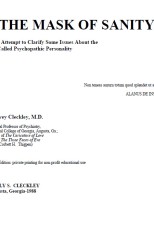
Author : Cleckley Hervey Milton
Title : The Mask of Sanity
Year : 1941
Link download : Cleckley_Hervey_Milton_-_The_Mask_of_Sanity.zip
THE FIRST EDITION of this book was based primarily on experience with adult male psychopaths hospitalized in a closed institution. Though a great many other psychopaths had come to my attention, most of the patients who were observed over years and from whom emerged the basic concepts presented in 1941 were from this group. During the next decade a much more diverse group became available. Female patients, adolescents, people who had never been admitted to a psychiatric hospital, all in large numbers, became available for study and afforded an opportunity to observe the disorder in a very wide range of variety and of degree. This additional clinical experience, helpful comment in the reviews of the first edition, enlightening discussion with colleagues, and an improved acquaintance with the literature all contributed to modify concepts formulated approximately ten years earlier. In attempting to revise the book for the second edition (1950), I found it was impossible to do justice to the subject by minor additions, deletions, and modifications. It was necessary to write a new and much larger book. For the third edition, published in 1955, fewer alterations and additions were necessary. But a number of important changes were made. Some reviewers led me to feel that in previous editions I failed to convey accurately or adequately the concept I had formed. It is not easy to convey this concept, that of a biologic organism outwardly intact, showing excellent peripheral function, but centrally deficient or disabled in such a way that abilities, excellent at the only levels where we can formally test them, cannot be utilized consistently for sane purposes or prevented from regularly working toward selfdestructive and other seriously pathologic results. Impressed by its effectiveness as used by Henry Head to distinguish a complex, deep, and obscure type of aphasia, I chose the term semantic to indicate my concept of a personality disorder which appears to have, at least hypothetically, some important similarities. A few readers were misled by my use of the term semantic to believe I claimed that the basic pathology in this disorder, or its cause, is deficiency in the understanding of speech or some other linguistic difficulty. Some comments, on the other hand, gave me the impression that it was assumed I had found fault with the psychopath because he could not achieve a final and absolute understanding of life's meaning at levels more or less eschatological. I restated my concept with the aim of making it more explicit, with the hope of being more articulate. Since the first edition of this book, revisions of the nomenclature have been made by the American Psychiatric Association. The classification of psychopathic personality was changed to that of sociopathic personality in 1958. In 1968 it was changed again to antisocial personality. Like most psychiatrists I continue to think of the people who are the subject of this book as psychopaths and will most often refer to them by this familiar term. Sociopath or antisocial personality will sometimes appear, used as a synonym to designate patients with this specific pattern of disorder. Although I spared no effort to make it plain that I did not have an effective therapy to offer, the earlier editions of this book led to contact with psychopaths of every type and from almost every section of the United States and Canada. Interest in the problem was almost never manifested by the patients themselves. The interest was desperate, however, among families, parents, wives, husbands, brothers, who had struggled long and helplessly with a major disaster for which they found not only no cure and no social, medical, or legal facility for handling, but also no full or frank recognition that a reality so obvious existed. Telephone calls from Chicago, Denver, Boston, and The West Indies and letters from Miami and Vancouver have convinced me that the psychopath is no rarity in any North American community but that his problem is, by what seems to be an almost universal conspiracy of evasion, ignored by those therapeutic forces in the human group that, reacting to what is biologically or socially morbid, have sensibly provided courts, operating rooms, tuberculosis sanatoriums, prisons, fire departments, psychiatric hospitals, police forces, and homes for the orphaned, the ill, the psychotic, and the infirm. The measures taken by the community to deal with illness, crime, failure, contagion are, one might say, often far from perfect. It cannot, however, be said, except about the problems of the psychopath, that no measure at all is taken, that nothing exists specifically designed to meet a major and obvious pathologic situation. Communications from physicians, sociologists, psychologists, students, and others from Europe, some from countries behind the Iron Curtain, and also from India, Australia, and other distant parts of the world continue to arrive. One interesting, stimulating and deeply appreciated comment came a few years ago from a physician stationed in Antarctica. These communications convince me that the psychopath presents an important and challenging enigma for which no adequate solution has yet been found. Although still in the unspectacular and perforce modest position of one who can offer neither a cure nor a well-established explanation, I am encouraged by ever increasing evidence that few medical or social problems have ever so richly deserved and urgently demanded a hearing. It is still my conviction that this particular problem, in a practical sense, has had no hearing. Although I still have no effective treatment to offer for the psychopath (antisocial personality), it has encouraged me to feel that this book has, perhaps, served a useful purpose in making clearer to the families of these patients the grave problems with which they must deal. Apparently many psychiatrists, and many other physicians, have over the years advised relatives of psychopaths to read The Mask of Sanity. The response of these relatives has given me deep satisfaction and has helped me to feel that efforts to pursue this study are not in vain. Although we may still be far from the goal of offering a cure, perhaps something has already been done to focus general interest on the problem and to promote awareness of its tremendous importance. This must be accomplished, I believe, before any organized attempt can be made by society to deal adequately, or even cogently, with the psychopath. Even now, thirty-four years after the first edition of this book was published, I often receive several letters a week from wives, parents, brothers, or other kinsmen of psychopaths. Most of these letters help me to feel that this book has at least enabled many people to see more clearly and realistically the nature of the problem with which they have had to deal blindly and in a strange and almost unique confusion. These correspondents often tell me that this book has been of great value in helping them understand better the disorder of a husband, wife, child, or sibling and plan more realistically and effectively to deal with situations heretofore entirely unpredictable and incomprehensible. I am most grateful for these generous and gracious expressions of approval. The many hundreds of letters thanking me for even such a modest achievement encourage me to feel that a fifth edition may be worthwhile and that it deserves my most serious thought and concern. It is a privilege to thank friends, colleagues, and others who have given me help and encouragement in formulating my concepts and in preparing material for this book. It could not have been written without the constant assistance of my wife, Louise Cleckley, who devoted many months of her time over the years not only to the routine of typing and proofreading but to the mutual effort of shaping the essential concepts to be presented into articulate form. Her notable contributions included stimulus, encouragement, and a wisely critical presence during the conative and affective fluctuations apparently inescapable in such a task. They were given in such quality as to be acknowledged as genuine psychotherapy. Dr. Corbett H. Thigpen, my medical associate of many years, has played a major part in the development and the revision of this work. His observations and his thought, available to me during innumerable pleasant and stimulating hours of discussion, have assisted and profoundly influenced my own conclusions. Without his limitless generosity in relieving me over long periods of heavy and urgent responsibilities in teaching and in clinical activity, it would have been impossible for this volume to be written. My debt to him in this, and my gratitude, I can acknowledge but cannot fittingly express. For similar assistance I am also grateful to my other medical colleagues, Dr. B. F. Moss, Dr. Jere Chambers, and Dr. Seaborn S. McGarity, Jr. Aid in clarifying several important points was given me also by John Creson and by Wayne Thigpen. In the preparation of the fourth edition Cornelia C. Fulghum's generous and effective efforts were indispensable. It is a pleasure also to express appreciation to Marilyn York, Linda Tingle, Patricia Lilly, and Patricia Satcher, secretaries who very kindly and effectively aided me on many occasions, and to my daughter, Mary Cleckley Creson, whose support has been constant and of inestimable value. The long-delayed appearance of this fifth edition of The Mask of Sanity would not have been possible except for the generous and superb contribution of Louise Thigpen. Her efforts in assisting me to organize scattered items of material, to formulate and present more effectively concepts still unclear in the script, will be held in memory by me, with admiration and with deep gratitude. Her work in typing difficult copy against deadlines and her sagacity in steering me clear of equivocations, and of blunders under pressure, were extraordinary and indeed beyond the call of duty. Her part in this revision of The Mask of Sanity I acknowledge and value as a genuine and gracious collaboration. HERVEY CLECKLEY. ...

Tourney Phillip - What I saw that day
Authors : Tourney Phillip F. - Glenn Mark Title : What I saw that day Year : 2011 Link download :...














